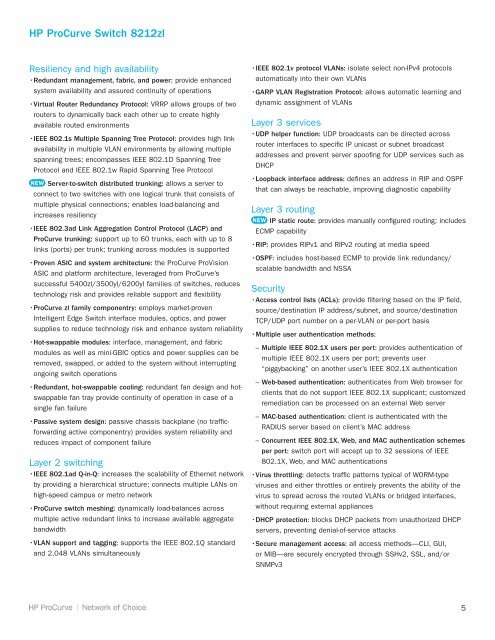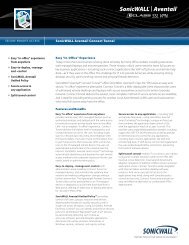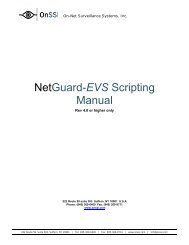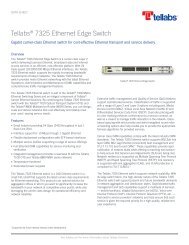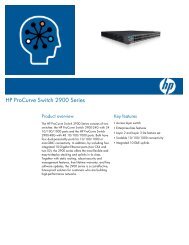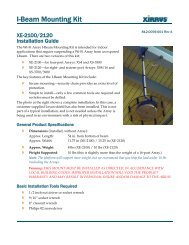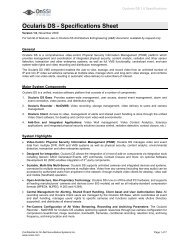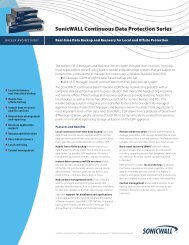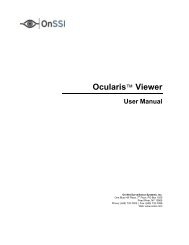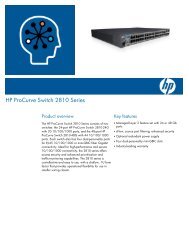HP ProCurve Networking Datasheets - Moonblink
HP ProCurve Networking Datasheets - Moonblink
HP ProCurve Networking Datasheets - Moonblink
You also want an ePaper? Increase the reach of your titles
YUMPU automatically turns print PDFs into web optimized ePapers that Google loves.
<strong>HP</strong> <strong>ProCurve</strong> Switch 8212zl<br />
Resiliency and high availability<br />
• Redundant management, fabric, and power: provide enhanced<br />
system availability and assured continuity of operations<br />
• Virtual Router Redundancy Protocol: VRRP allows groups of two<br />
routers to dynamically back each other up to create highly<br />
available routed environments<br />
• IEEE 802.1s Multiple Spanning Tree Protocol: provides high link<br />
availability in multiple VLAN environments by allowing multiple<br />
spanning trees; encompasses IEEE 802.1D Spanning Tree<br />
Protocol and IEEE 802.1w Rapid Spanning Tree Protocol<br />
NEW Server-to-switch distributed trunking: allows a server to<br />
connect to two switches with one logical trunk that consists of<br />
multiple physical connections; enables load-balancing and<br />
increases resiliency<br />
• IEEE 802.3ad Link Aggregation Control Protocol (LACP) and<br />
<strong>ProCurve</strong> trunking: support up to 60 trunks, each with up to 8<br />
links (ports) per trunk; trunking across modules is supported<br />
• Proven ASIC and system architecture: the <strong>ProCurve</strong> ProVision<br />
ASIC and platform architecture, leveraged from <strong>ProCurve</strong>’s<br />
successful 5400zl/3500yl/6200yl families of switches, reduces<br />
technology risk and provides reliable support and flexibility<br />
• <strong>ProCurve</strong> zl family componentry: employs market-proven<br />
Intelligent Edge Switch interface modules, optics, and power<br />
supplies to reduce technology risk and enhance system reliability<br />
• Hot-swappable modules: interface, management, and fabric<br />
modules as well as mini-GBIC optics and power supplies can be<br />
removed, swapped, or added to the system without interrupting<br />
ongoing switch operations<br />
• Redundant, hot-swappable cooling: redundant fan design and hotswappable<br />
fan tray provide continuity of operation in case of a<br />
single fan failure<br />
• Passive system design: passive chassis backplane (no trafficforwarding<br />
active componentry) provides system reliability and<br />
reduces impact of component failure<br />
Layer 2 switching<br />
• IEEE 802.1ad Q-in-Q: increases the scalability of Ethernet network<br />
by providing a hierarchical structure; connects multiple LANs on<br />
high-speed campus or metro network<br />
• <strong>ProCurve</strong> switch meshing: dynamically load-balances across<br />
multiple active redundant links to increase available aggregate<br />
bandwidth<br />
• VLAN support and tagging: supports the IEEE 802.1Q standard<br />
and 2,048 VLANs simultaneously<br />
• IEEE 802.1v protocol VLANs: isolate select non-IPv4 protocols<br />
automatically into their own VLANs<br />
• GARP VLAN Registration Protocol: allows automatic learning and<br />
dynamic assignment of VLANs<br />
Layer 3 services<br />
• UDP helper function: UDP broadcasts can be directed across<br />
router interfaces to specific IP unicast or subnet broadcast<br />
addresses and prevent server spoofing for UDP services such as<br />
DHCP<br />
• Loopback interface address: defines an address in RIP and OSPF<br />
that can always be reachable, improving diagnostic capability<br />
Layer 3 routing<br />
NEW IP static route: provides manually configured routing; includes<br />
ECMP capability<br />
• RIP: provides RIPv1 and RIPv2 routing at media speed<br />
• OSPF: includes host-based ECMP to provide link redundancy/<br />
scalable bandwidth and NSSA<br />
Security<br />
• Access control lists (ACLs): provide filtering based on the IP field,<br />
source/destination IP address/subnet, and source/destination<br />
TCP/UDP port number on a per-VLAN or per-port basis<br />
• Multiple user authentication methods:<br />
– Multiple IEEE 802.1X users per port: provides authentication of<br />
multiple IEEE 802.1X users per port; prevents user<br />
“piggybacking” on another user’s IEEE 802.1X authentication<br />
– Web-based authentication: authenticates from Web browser for<br />
clients that do not support IEEE 802.1X supplicant; customized<br />
remediation can be processed on an external Web server<br />
– MAC-based authentication: client is authenticated with the<br />
RADIUS server based on client’s MAC address<br />
– Concurrent IEEE 802.1X, Web, and MAC authentication schemes<br />
per port: switch port will accept up to 32 sessions of IEEE<br />
802.1X, Web, and MAC authentications<br />
• Virus throttling: detects traffic patterns typical of WORM-type<br />
viruses and either throttles or entirely prevents the ability of the<br />
virus to spread across the routed VLANs or bridged interfaces,<br />
without requiring external appliances<br />
• DHCP protection: blocks DHCP packets from unauthorized DHCP<br />
servers, preventing denial-of-service attacks<br />
• Secure management access: all access methods—CLI, GUI,<br />
or MIB—are securely encrypted through SSHv2, SSL, and/or<br />
SNMPv3<br />
5


